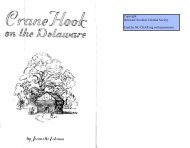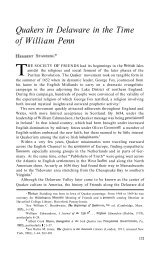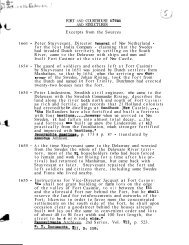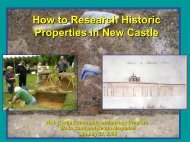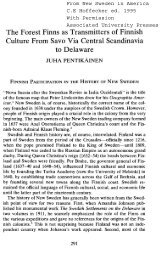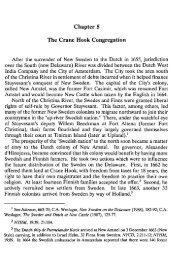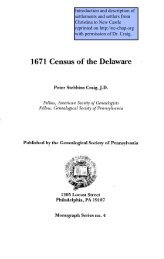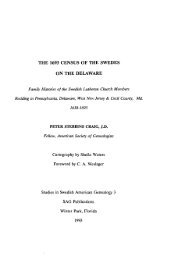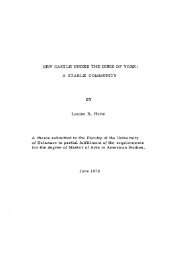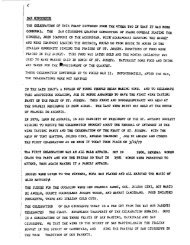You also want an ePaper? Increase the reach of your titles
YUMPU automatically turns print PDFs into web optimized ePapers that Google loves.
1<br />
* .<br />
'<br />
d -.<br />
THE STRAND<br />
Tile Hous-8 Site<br />
Original Strand Flot, 60'<br />
Present 9wner Lesley H. George<br />
Ao~roximatelv that of resent #54<br />
Original Plot - 11<br />
The Tile house site in 1657 aas a 60' x 300' plot extending<br />
fron the Strand west tg the Green. This plot belonged to "alilliam<br />
~.Iaurits" - '!:illia~ Xorris, an Znglishnan frca Cornsall, who had<br />
become a Dutch citizen. idaurits also owned the adjoining ?lot to<br />
the south (see srrnmary of that plot, 9-10, now the south part of<br />
the garden of #54, Read alley and part of the Read house). %il-<br />
liam Liaurits may have owned also, the adjoining plot to the north<br />
extending 60' to Karmony Street and 300' deep to the Green. (No<br />
deed or other record cf ownership for this corner lot during the<br />
Dutch period and first decade of the Duke of York period has been<br />
found so far.)<br />
For the Tile 3ouse site the early ownership is determined by<br />
deeds and court records for the adjoining plot to the south, which<br />
gave the Tile house lot as its north boundary. Following Xaurits,<br />
however, there is no further record until 1678, when the lot is<br />
cited in court as recently the property of "bIoses ~egan" (lv~oses<br />
~'~onne, a boatman), purchased from him by John Boyer. Boyer was<br />
applying in the court for a certificate of ownFshi2, which was<br />
granted, to enable hin to secure a legal deed from the governor<br />
at New York.*
-2-<br />
(Original ?lot 11, continued)<br />
Xo further record of the property has been fmnd for the -e-<br />
3ainder of John 3oyer1s lifetime, but i~z1raediat~ly ayter his ~23th<br />
in 1703 or 1704, the house and lot Kere boi~ght from the tuo "dtiu~n-<br />
ters and co-heirs of john Boyer" by Joseph ~ood, ~ h at o that tine<br />
owned ths house and lot next dmr t9 the south.* The Tile<br />
lot had "a small house" on it at the tirne Boyer bought it frog<br />
CIGonne. According to ths numerel tie bolts on the Ti19 house,<br />
1687, Boyer replaced ~'Gonne's saall house that year by the house<br />
later described as "a large brick dwelling'!.<br />
Jan Earnensen, the carpenter, who lived next door (in the<br />
house afterward in the possession of Joseph 'load), may have been<br />
the craftsman engaged to build the Tile house; he mas a prominent<br />
builder at the time, and appraiser of propsrty for the co-wt, and<br />
he mas Dutch. The Boyer fmily, long in the service of the Dutch<br />
Eas of French origin, probabJy Hugenot who had fled from France to<br />
/<br />
the protectim of Holland. /<br />
Alexander Boyer, the father of John, was deputy-commissioner<br />
for the Dutch on the Delaware River in 1648, with headquarters at<br />
Port Nassau, near tne site of Gloucester, Nem Jersey, He wss also<br />
interpreter for the Dutch with the Indlans, and In that capacity<br />
came with Peter Stuyvesant, the Dutch director-general, when he<br />
built Fort Casimir in 1651. Alexander Boyer remained at Fort Casi-<br />
mir, until after the Swedes captured th2 fort in 1654. The Swedes<br />
*Yo dinensions of the Tile house lot are given in this sale but<br />
later indentures show that it was 60' x 300',
C.<br />
\ ,/'<br />
-Id<br />
IL<br />
(?lot 11, continued)<br />
did not like him becauso of his "contempt" for their autnori ty,<br />
but as he hed "E! S~edish :;ifell lie ir:tls offered the privileges of a<br />
Swedish colonist. He accepted, but left sgon Tor lhn'nattan, re-<br />
turning the next ycsr nhen Stuyvezant v.;ade his conqilest af the<br />
whole river fro3 the Sv:edas.<br />
-<br />
klexsneer L-oycr brought 1;: s f tz.i'lj~ frog :knhattan - his ;~ife<br />
and three children, John, Josyn, and Thornas. John milen he vas old<br />
enough became a soldier, his sister Josyn (Josie) mrried a soldier,<br />
John Xzrshall. Soyer, Xsrshall 2nd two other soldiers, Robert<br />
-<br />
Scott and John Cousins, sere grznted jointly in 1569, a tract of<br />
400 acres near "Christina Town" - to be cultivated and planted by<br />
them. They sold this farm in 1675 to Justa kndries.<br />
John Xarshall, Josie Boyer's husband, died and she married<br />
;?illian Semple, of New Czstle, a justice of the court. John and<br />
Josie were among those who requested naturalization by Yiilliam<br />
Penn in 1683. Jo?n had already served as sheriff under the Guke<br />
of York in 1680-81, and perhaps longer.<br />
The surname of John Bayer's first wife has n ~ been t determined.<br />
In a court case in 1680, her first name is Leitie, a farniliar given<br />
nane in i3ew Castle ind->ntures of the early Dutch-Znglish periodc.<br />
In 1702, when Joseph Hansen, large land oaner in Red Lion Hun-<br />
dred, conveyed to John Boyer 100 acres north of Dragon Swamp, Han- ,<br />
sen made the transfer nout of the love and affecti~n that I bear
-4-<br />
(Plot 11, continued><br />
c~to rc:- kr-oti3sr-in-law ~s also for Givers othsr causes and con-<br />
sideraci2nsi1. 'The 9x1;- sister 9f ., asi~;.h Hariser-, accordin? to<br />
their father's rill, wss nnn, vL-lo rnay i-1-se b,en Zohn B,lyf.rl s sec-<br />
ond rife. (It is possible of cause that john Boysr ha,; zr~other<br />
sister brn Ic.ter than the three chllbren ~nenti~ned in the Lutch<br />
recards oI' 1660, ;.2-.:, -i(-*ht<br />
I ~ A h~i~2<br />
~ :nrrried L-osel~h<br />
.- 7 .<br />
2 ..b<br />
. -<br />
z:.znsen; or ; osis<br />
.,--:,t i;sve r.zrr:ed hi:; after >er sec3nu hil~'op;q ,, ,A,d, ,!illla:; Uensle<br />
die; in 1652.)<br />
Alexaguer Eoyer had E 2lantctian up tha river a short dis-<br />
- now Fourth Street just south of 3elcnwzre Strset. 1'0 mention of<br />
d him has been found after the 2ngiish esne in 1664, so he inay have<br />
died betneen 1660 and 1664 or soon afterv;e.rd. Praperty is aen-<br />
tioned in 1667 as "for~uerly belonping!' ti~ hi~i, but surviving rec-<br />
ords are sufficient to prove that Alexander 5oyer was one of the<br />
founding settlers of Gevr Szstle; and also that he was a nan of<br />
ability and inte,rity, judging from the positions he held during<br />
the period of Dutch activity on the river.<br />
In the same year, 1678, that John Eoyer bought ths Tile<br />
house lot aith the "small house!', frm Iiosas II1Gonn9, he and<br />
D'Gonne were granted a2joining lots 60' x 3013' feet on Lad Street,<br />
now Second Street, north of Harmony. The %sposltion of these<br />
lots has not yet been determined, but John 3oyer rn7lst have sold<br />
a his in 1696 or the foilo~inj year, for he is taxed for tso town<br />
lots in 1685 and for one lot in 1687 - the yesr or the building<br />
of the Tile house.
-5-<br />
(Plot 11, continued)<br />
John So;ler1 s daughter1 s in:ierited along ~:i th the Tile house,<br />
the bank lot opy:oeite, and this crss include?. in the sale t o J3-<br />
. .<br />
seph r.ood.<br />
;ose?h ;,sod nes a land-onner sn Long Island cs early ~s 1673.<br />
:!;hen he came to the Dele.~:are h.js nat Seen deternlned; he ivitnessed<br />
z ~ro~erty trsnsfer at Xen C~stie in 1635, vras in possession of<br />
the lot ad9ining the Tile h3use site in 1701, 2nd that saae year<br />
acquired two plantations i~nlediately north of k;eu Ccstle. In<br />
-..<br />
170a, at the request of Tiessel Alrichs the ratiring sheriff, ;::il-<br />
lian Benn a2pointed Joseph sheriff in Alrichs' place.<br />
e: Joseph Wood must have held a large mortgage or claim 2gainst<br />
the Boyer estate, for the deeds to him convey the property for 5<br />
* in<br />
pounds to bind the bargain "as also for divers other good causes<br />
and valuable considerations."<br />
John Boyer had mcre land in 3ed Lion Zundred than the 100<br />
acres conveyed to him by his brother-in-lalJ Joseph Hansen in 1702.<br />
That same year John Boyer sold (to Eenry ~arker) 200 acres on half<br />
of the former dwelling 2lantation of Joseph Hansen. This may have<br />
been a mortgage, for in 1705, Joseph ..ood, at the time he wzs buy-<br />
ing the Tile house from Boyer's daughters, bought a plentation of<br />
350 acres rrom Zoseph Yansen in the sms genercl location. Thomas-<br />
Boyer, John's son, had re-surveyed to him that sane year 100 acres<br />
this region. Vhether i:his tract had belonged to his father and<br />
was re-surveyed because of his inheritance, has not yet been
-6-<br />
(plot 11, continued)<br />
deterrained in this search, but that some of the Soyer property in<br />
Xed Lion Hundred descended to Thomas Boyer is indicated in the<br />
records. Some of his descendents moved to Kent County, Selaaare,<br />
- -<br />
and some to Maryland. Those who renained in ~ ~ Csstls e v County<br />
bought the sheres of those who left in the farns. No further rec-<br />
ords of the two daughters of John Eoyer nzve been found to date.<br />
One r:as sarried to Faul Thoolas, yeoman, 3f Yew Czstle C~unty. The<br />
other to Thomas Gill-Johnson, yeoman, formerly of I;eirl Castle, but<br />
at the time of the sale of the Tile house, of iu'evr Jersey.<br />
In 1716, Joseph iiood sold the Tile house property to Cr.<br />
Patrick Reilly, physician of Idew Castle, who during his lifetime<br />
owned much valuable property in Xer, Castle and had a large brick<br />
yard near the river south of the town.<br />
After Dr. Reilly's death and the death of his wife, mho was<br />
executor, the Tile house property was seized by the sheriff and<br />
sold for a claim against Gideon 3riffith (who had married Iv!ar-<br />
garet, the widow of Er. Reilly, and was administrator of what mas<br />
left of Dr. Reilly's estate). Dr. John Finney, the highest bid-<br />
der, bought the "large brick house" znd lot in the Front Street<br />
for 150 pou~ds 5 shillings. Other indentures show that this sum<br />
-<br />
did not represent the total Dr. Finney invested in the house, for<br />
in a re-sale of the property by Dr. Finney to Gideon Griffith for<br />
155 pounds, the title aould not become effective until Griffith<br />
L had paid in addition e mortgage debt to John Richardsan, amount not
-7 -<br />
(Plot 11, continued)<br />
stated. Later, a debt of 3r. Finney agaicst Griffith in connec-<br />
ti3n with this house xas 200 pounds.<br />
The property at thi~ time had sn adjoining plot at tkie corner<br />
of Second and Harmony Streets i:hich Dr. Reilly had b~ught fro2 :il-<br />
lim and Rebecca Earney, the latter one of the heirs of Johanncs<br />
DeEaes. (see Sumnary of Eapony ~.nd Secan5 Street plots.)<br />
To recover the debt of Gideon Griffith to Dr. John Finney of<br />
200 pounds, the Tile house and ground ~1.2~ sold by the sherif-ad<br />
sold to Anthony Jhitely in 1754. His aidovf, Abigail ;,hitely ac-<br />
quired the property in 1758. She married John Fassmore, survived<br />
him, and her exkcutors sold the house and land to Israel Israel in<br />
1782. From Israel it went to YJillian Armstrong, innkeeper, in<br />
1796, the same year he bought the property adjoining to the south<br />
where he kept a tavern.<br />
'Rilllam Armstrong divided the 60' Tile house plot zs he did<br />
the adjoining 63' plot to the south, both of vurhich extended from<br />
the Strand to Second Street when he bought them. To Anne Yeates<br />
in 1803, sold the housg, "known by the name of Tile ~ouse" with<br />
ground measuring 36' on the Strand, extending back 91' at this<br />
width and thec narrowing for the balance of the total depth of<br />
177'. The front width of 36' included an alley on the south side,<br />
running back 68' to a ivell. The alley and the well were to be for<br />
,'<br />
b uae in common between Anne Yeates, and Daniel XcArthur to whom
-e-<br />
(Flot 11, continued)<br />
anstrong wes selling at the same time, the balance of the Tile<br />
house plot south ~f the alley - 25' front by 39' deep. arrnstrdng<br />
retained the orizinel Tile house ground Sohind this snall front<br />
lot, in connection with his tavern adjoining the 25' lot on the<br />
south.<br />
(For the 25' lot originally Selonging to the Tile house, see<br />
end pzges of this summzry.)<br />
About t5e aiddle of the 19th century, Anne Yeates ('hrooster)<br />
and her brother John sold the Tile house to Thomas Eobinson, who<br />
died in 1873. From the hobinson family the plot wzs acquired by<br />
w Lawrence Cormer who sold the same year, 1883, to Alexander Be<br />
Cooper. Carolyn B. Rogers acquired the Tile house plot from heirs<br />
'L<br />
of the Cooper family in 1909.<br />
At what tine and under whose ov~nership the Tile house began<br />
to suffer from neglect has not been determined. A visitor ar-<br />
riving at New Castle by ship in 1822 writes:<br />
"'dent ashore into the main front street, to see the house<br />
built in 1687, after the manner of the houses in Holland, of brick<br />
aid to have been imported from there. The bricks are very small,<br />
yellowish, and now rough-cast with plaster. It presents its gable<br />
end to the front street -- the roof is remarkably deep, making two<br />
stories in itself. The end walls are higher than the roof and have<br />
regular steps on their upper surface above the roof. The year,<br />
1687, is in iron letters, as clamps, on the front ~vall. 3ne feels<br />
a sentiment of veneration at seeing such vestige of antiquityea<br />
The house, as here described, was painted after the middle<br />
of the century by a nember of the Rogers fanily. The original ia<br />
now in the possession of' Mrs. bdlound Rogers of' New Castle. At some
-9-<br />
(Plot 11, continued)<br />
tine it had acquired t w front ~ doors. ~{ot enough icfornztion nxs<br />
been available to date re~srding the occu9:;tlons of the r:ners<br />
during the 19th century to list the co:.c:nercia'l purposes for ;vhkh<br />
its front rooms or ~ ~ 1of - t its front aas used for years.<br />
-<br />
dexanaer 2. Cooper, writing in 19CS scid tnat utll about<br />
19S5, the hoase stood in its ze~era: aatlines zs it had stood for<br />
yews, but .:ias in a very dsle~idatcd cmditlon, znd sas >ulled<br />
down about that time, except for its founsatlans c.26 about 6 feet<br />
of its front wall. The 2hot0gra;:~h taken in the 135Cfs, recently<br />
discovered by Zir. Thomas ?olcon?b, shows the aelapidated condition,<br />
and also the arched wall rdlich then closed in the alleyway that in<br />
b 1803 led to the well at the back.<br />
The present house, built for LIrs. Csrolyn flogers, after she<br />
acquired the plot in 1909, by jLr. Lzussat Rogers, was not built<br />
upon the exact site or foundations of the original Tile house,<br />
the north wall of mhich had been used as a party wall by Gr. Jmes<br />
11:cCallnont who built #56 the Strand before 1800. An alley-viay was<br />
left between the new Rogers house and the house formerly of Dr.<br />
McCelloont. The Rogers hguse has been remodelled, since it ass<br />
first built, into its present forx.
a<br />
(Plot 11, continued)<br />
i:cArthur bits, formerly on the<br />
South 25 feet of Tile house lot<br />
No i~dicetion has been found in the records that a dwellin;;<br />
or shop had Se9n built on the prt of the Tile house lot south<br />
of that house before 1603 when .illizx -\rastrong, innkea?er, hsv-<br />
ing bought the vrhoie Tile hodse 2ro2e1-t:. nG;;i diirided it;, selling<br />
the Tile house on a 36' lot, to hnn Xeates, and selling the re-<br />
~aining 25' by 39' deep, t9 Daniel :.:cArthur. The lack of mention<br />
does not establish the absence 3f a building, however, and the<br />
price, $500, for this sxall l~t (v~ith use of the Tile h3u5 e alley<br />
and well) could have covered a building of some kind in the year<br />
of the purchase, 1803. Three years later, 1806, Daniel l:cArthur<br />
ssld the property as I1house and lot n for $1,000, to ktkinson and<br />
Thomas Rose. Thomas bought ktkinson's share for $500, and in<br />
1809 Thomas Rose, merchant, sold the property "beginning at the<br />
corner of Zillim Armstrong s dwelling house and tavern" and<br />
bounded north by the Tile house, far $2,000. The purchaser named,<br />
':Lewis Rush n of ?hiladelphia, has not been found in any other in-<br />
dentures to date, and further search will be made later. The<br />
property is mentioned in 1824 by Dr. Jmes Cooper 3r. (who then<br />
ovmed Nil1 iam Lrxs trong ' a former "dwelling home and tavern n next<br />
door) as having escaped the fire. lhether Dr. Cooper owned this<br />
--<br />
house also has not been discovered.<br />
hhether the house shown on the smith 25' of the original Tile<br />
house site, in the photograph taken about 1880, is the same 8s the
~nporzance or ILS preueoe~su~-s GI~UUAL UG uLuwv uU<br />
Lty of reconstructing the Tile house and perhqs<br />
. .







